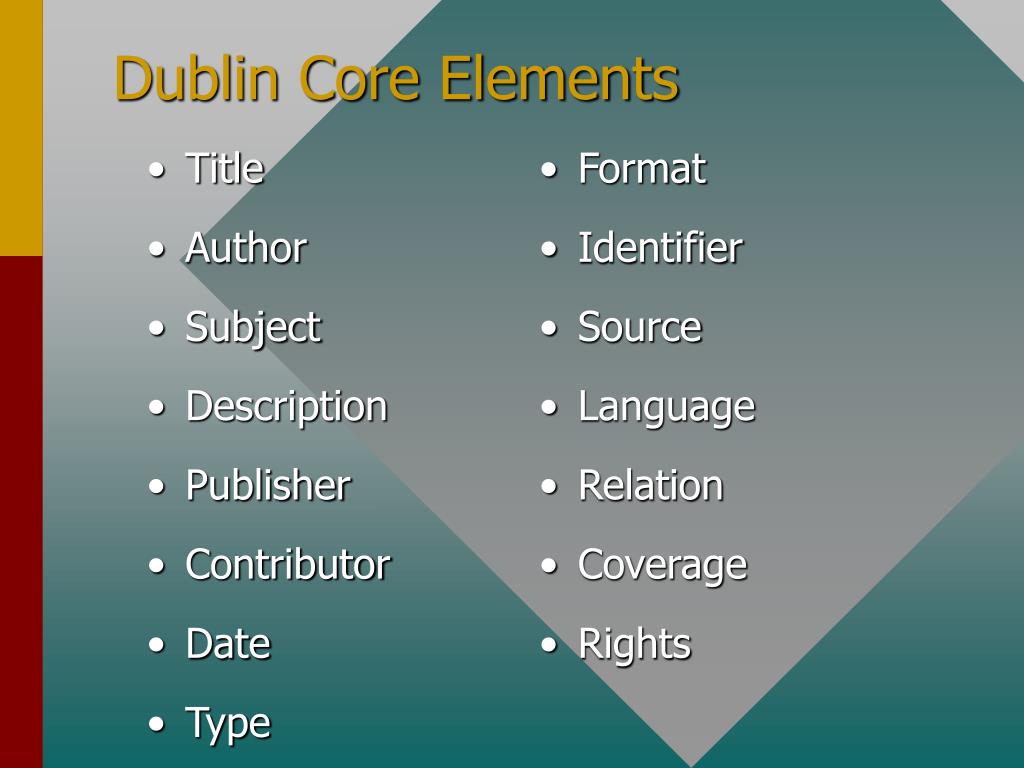

Spatial applicability of the resource, or the The spatial or temporal topic of the resource, the Name of a Contributor should be used to indicate References Įxamples of a Contributor include a person,Īn organization, or a service. Over time, however, implementers are encouraged to use the semantically more precise dcterms: properties, as they more fully follow emerging notions of best practice for machine-processable metadata.

The RDF schemas of the DCMI namespaces describe the subproperty relation of dcterms:creator to dc:creator for use by Semantic Web-aware applications. Implementers may freely choose to use these fifteen properties either in their legacy dc: variant (e.g., ) or in the dcterms: variant (e.g., ) depending on application requirements. These fifteen new properties have been defined as subproperties of the corresponding properties of DCMES Version 1.1 and assigned domains and ranges as specified in the more comprehensive document "DCMI Metadata Terms". Rather, fifteen new properties with "names" identical to those of the Dublin Core™ Metadata Element Set Version 1.1 have been created in the dcterms: namespace ( ). So as not to affect the conformance of existing implementations of "simple Dublin Core™" in RDF, domains and ranges have not been specified for the fifteen properties of the dc: namespace ( ). Since January 2008, therefore, DCMI includes formal domains and ranges in the definitions of its properties. When a given property is encountered, an inferencing application may use information about the domains and ranges assigned to a property in order to make inferences about the resources described thereby. Domains and ranges express the meanings implicit in natural-language definitions in an explicit form that is usable for the automatic processing of logical inferences. Domains and ranges specify what kind of described resources and value resources are associated with a given property. Since 1998, when these fifteen elements entered into a standardization track, notions of best practice in the Semantic Web have evolved to include the assignment of formal domains and ranges in addition to definitions in natural language.

This document, an excerpt from the more comprehensive document "DCMI Metadata Terms" provides an abbreviated reference version of the fifteen element descriptions that have been formally endorsed in the following standards: The namespace policy describes how DCMI terms are assigned Uniform Resource Identifiers (URIs) and sets limits on the range of editorial changes that may allowably be made to the labels, definitions, and usage comments associated with existing DCMI terms. Īll changes made to terms of the Dublin Core™ Metadata Element Set since 2001 have been reviewed by a DCMI Usage Board in the context of a DCMI Namespace Policy. The terms in DCMI vocabularies are intended to be used in combination with terms from other, compatible vocabularies in the context of application profiles and on the basis of the DCMI Abstract Model.
#Dublin coreclasses full
The full set of vocabularies, DCMI Metadata Terms, also includes sets of resource classes (including the DCMI Type Vocabulary ), vocabulary encoding schemes, and syntax encoding schemes. The fifteen element "Dublin Core™" described in this standard is part of a larger set of metadata vocabularies and technical specifications maintained by the Dublin Core™ Metadata Initiative (DCMI). The name "Dublin" is due to its origin at a 1995 invitational workshop in Dublin, Ohio "core" because its elements are broad and generic, usable for describing a wide range of resources. The Dublin Core™ Metadata Element Set is a vocabulary of fifteen properties for use in resource description. Like other Web-oriented vocabularies of the late 1990s, the Dublin Core was published with a version number, "1.1", after which the practice of publishing new releases as numbered versions was abandoned in favor of publishing releases simply by date. This version of the fifteen-element Dublin Core, from 2012, is provided here as a historical snapshot. Documentation for these core properties is now included as part of the larger set of DCMI Metadata Terms.
#Dublin coreclasses iso
This fifteen-element Dublin Core was first standardized in 1998 as IETF RFC 2413, "Dublin Core Metadata for Resource Discovery", and subsequently published as ANSI/NISO Z39.85 and ISO 15836. "The Dublin Core", also known as the Dublin Core Metadata Element Set, is a set of fifteen "core" elements (properties) for describing resources. Please see the DCMI Metadata Terms for the current documentation of its fifteen terms Please note that this version of the specification for the Dublin Core Element Set is somewhat out of date.


 0 kommentar(er)
0 kommentar(er)
